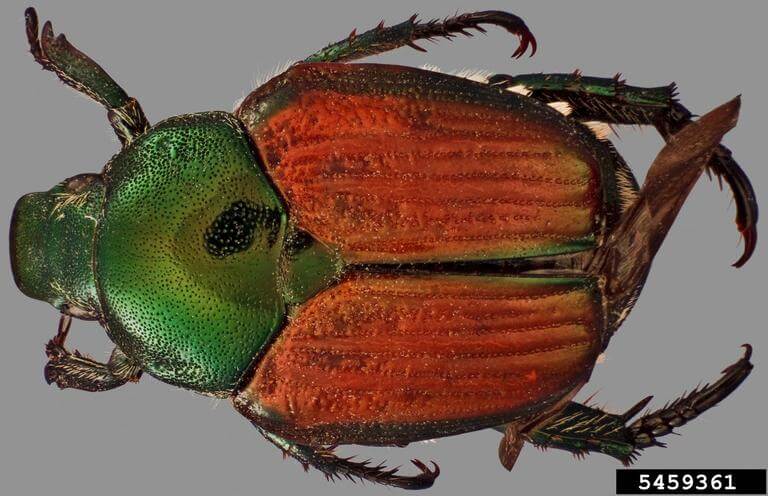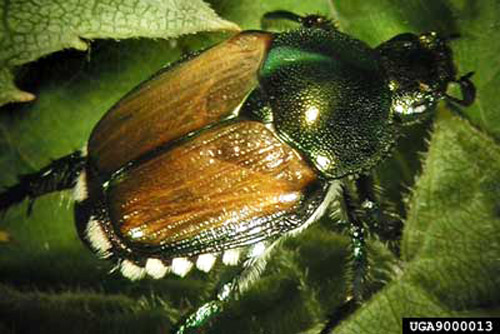japanese beetle life cycle in missouri
They overwinter as third instar larvae in the soil below the frost line. The first beetles out of the ground seek out suitable food plants and begin to feed immediately.

How To Get Rid Of Japanese Beetles Effectively 2022 Pestkilled
Japanese beetles often feed in groups of up to 25 on a wide variety of plants.

. Adult Japanese beetles feed on and damage some field crops ornamental plants shrubs and garden plants. Beetle populations fluctuate from year to year driven by how successful the grubs are at finding turf to feed on. Appearance of adult the timing of oviposition and subsequent development have been shown to vary with latitude altitude and also from year to year Fleming 1972.
The adults emerge during the summer months to feed on above ground plant material returning to the soil to lay eggs in the late summer. The Japanese beetle has a complete lifecycle with an egg stage a larval or grub stage a pupal or resting stage and the adult beetle stage. The males usually are.
Studies with Japanese beetles under captivity have shown variations as wide as 9 to 74 days in males and 17 to 105 days in females. As soil temperatures warm in the spring the larvae move closer to the soil surface. These grubs grow to about an inch long and lie in a curled position.
They descend 48 feet into the soil to overwinter. The Japanese beetle occurs in all states east of the Mississippi River with sporadic infestations reported in California Iowa Missouri and Nebraska. The larvae feed on roots of grass and other plants close to the surface of the soil.
Japanese Beetle continued LUCE Japanese beetles overwinter as a par-tially grown grub in the soil below the frost line. In central Missouri this typically occurs in mid to late June. University extension and state agriculture departments help people control the Japanese beetle.
The eggs hatch into white grubs in ten days to two weeks or longer depend- ing on soil temperature. The scarab beetle family is very large with breathtaking variety and often great beauty. On warm sunny days the new beetles crawl onto low growing plants and warm for a while before taking flight.
In most parts of its range the Japanese beetle completes its life-cycle in one year but some populations in cooler climates may complete their development in two years Vittum 1986. The host range of this insect is very large over 300 species of plants. Life cycle After mating females burrow a few inches into the soil and lay eggs 4060 during a summer.
The egg larva and pupa life cycle stages develop underground and unless soil is removed or dug into these life stages will not be seen. Life cycle After mating females dig into rich soil to deposit their eggs which hatch in a little over two weeks. Japanese beetle are distinguished from native beetles by the presence of five pairs of white tufts on their abdominal sides and two additional tufts on the abdomen tip.
The adult Japanese beetle lives above- ground for about 2 summer months and spends about 10 months under- ground. This insect spends about 10 months a year in the ground in the larval stage. The life cycle of the insect has a major influence on the type of damage seen with this pest.
The generally accepted range is 30 to 45 days Fleming 1972. Japanese beetles have a univoltine life cycle one generation per year. As soil temperatures warm in the spring the larvae move closer to the soils urface.
After pupating in the stage between larva and adult in the soil adult Japanese beetles emerge in midsummer. Each of the first two larval instars stages requires a feeding period of about three weeks. Relatively high numbers of beetles over the past few years.
They are oval or elongated stout usually with rounded backs and have clubbed antennae with. Wednesday January 19 2022. Eggs hatch in the early fall and the larvae remain underground feeding on roots until pupation in the late spring.
Japanese beetles overwinter as a partially grown grub in the soil below the frost line. The adult Japanese beetle is a little less than half an inch long and has a shiny metallic-green body with bronze-colored outer wings. This is harder for them in years when July and August are dry.
The life of adult beetles is relatively short under high temperatures and long under low temperatures Fleming 1972. Orkin Termite Treatment Pest Control Exterminator Service. Observing Japanese beetles feeding on plants is quite common since the adult beetle feeds on about 300 species of trees shrubs ornamental and fruit trees in addition to vegetable crops.
There are parasitoid wasps and flies that lay eggs inside Japanese beetles that have been reported anecdotally in Minnesota. The grubs live underground for a year feeding on plant roots and decaying plant matter molting as they grow. Japanese beetle have one generation per year Figure 2.
The grubs resume feeding on grass roots in the spring and then pupate near the soil surface. They descend much lower into the soil to overwinter. Exact date ranges vary depending on weather.
The beetle has six small tufts of white hair along the sides and back of its body under the edges of its wings. In late autumn the grubs burrow 48 inches into the soil and remain inactive all winter. How to Recognize the Japanese Beetles Life Stages.
Japanese beetles have a univoltine life cycle one generation per year. The grubs live underground for about a year feeding on plant roots molting as they grow. Adult Japanese beetles appear around the middle of June and they live for about two months.
Adults emerge between May and July depending on their geographic location. Larvae that have matured by June pupate and the adult beetles emerge from the last week of June through July. Virgin females immediately release a.
Home Unlabelled Japanese Beetle Life Cycle In Missouri - Why You Re Seeing So Many Japanese Beetles In 2020 Plant Sentry Japanese beetles are destructive plant pests. Adult beetles are metallic green with brown wings approximately 5-7 mm wide and 8-11 mm long Figure. Although many are black brownish or drab many scarabs are colorful some with iridescent greens and other colors others looking as if they were covered with shiny enamel paint.
They over winter as third in star larvae in the soil below the frost line. It completes this cycle once every year.

Japanese Beetle Soybean Pest Soybean Research Information Network Srin

Japanese Beetle Space For Life

Effective Management Remains Elusive For Beetle That Eats Almost Anything

Japanese Beetle Popillia Japonica

Japanese Beetle Control The Good Earth Garden Center

Japanese Beetle Identification Scouting Integrated Pest Managment University Of Missouri


